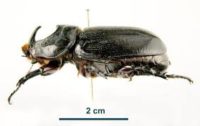
Scientists confront new type of coconut rhinoceros beetle invading islands in the Pacific
During the 25th International Congress of Entomology (ICE) in Orlando, Florida, which took place from 25–30 September 2016 – the largest gathering of its kind ever held – scientists met in a special symposium to find answers to the problem of scarab beetles – an invasive species that is currently spreading around the globe.
The meeting was timely, with reports of a new, highly damaging biotype of the coconut rhinoceros beetle recently established in a number of Pacific Islands, including Hawaii, and reports of the ornamental and turf damaging Japanese beetle established for the first time on the European continent in Italy. Scientists are concerned that increasing international transport and new races of pests are challenging our quarantine systems, which if compromised, will result in severe and ongoing damage.
A new biotype of the coconut rhinoceros beetle poses a special threat. The pest has invaded Guam, where entomologist Dr Aubrey Moore predicts that if effective control measures cannot be found, more than 50 per cent of the palms on the island will be killed. The damaging beetle was found to belong to a new biotype by AgResearch New Zealand scientist Dr Sean Marshall, and has since been found wreaking havoc on a number of other Pacific Islands. The beetle has established a beachhead in Hawaii, where Project Operations Manager Dr Darcy Oishi is running a multi-million dollar programme to contain and eradicate the pest.
Representative of the Pacific Community, Dr Maclean Vaqalo, said the real threat is to the small countries and atolls of the Pacific where the coconut is considered the ‘tree of life’, providing essential food and shelter for the people there. If nothing is done to help the small island states in the Pacific to contain the pest, it will simply re-invade the cleared areas and may even reach the American continents.
A special meeting was called by Phil Andreozzi of the U.S. Department of Agriculture, Animal and Plant Health Inspection Service (APHIS), to take advantage of the group of scientists present, to develop a plan to address the problem of the coconut rhinoceros beetle in the Pacific. The expert team began work on an operational framework and established working groups to increase awareness of the problem, plan emergency responses, enhance biosecurity, and look for long-term biological solutions. Participants were pleased with the meeting and the platform offered by ICE to begin to address the problem in a coordinated fashion in order to overcome this severe threat as soon as possible.
Copyright © 2024. Pacific Community.